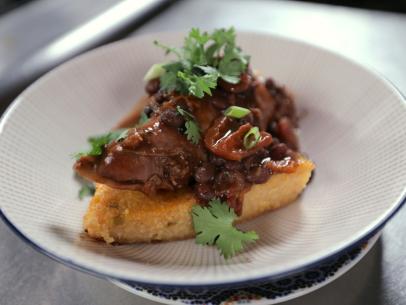
Recipe courtesy of Anne Burrell
Rabbit with Spring Vegetable Ragu and Polenta
Getting reviews...
- Level: Advanced
- Total: 3 hr
- Active: 3 hr
- Yield: 4 servings
- Level: Advanced
- Total: 3 hr
- Active: 3 hr
- Yield: 4 servings
Ingredients
Rabbit:
Spring Vegetable Ragu:
Polenta:
Directions
Special equipment:
butchers' twine- Preheat the oven to 450 degrees F. Cut the rabbits as follows: With a sharp cleaver, cut off the front portions (from right behind the front legs) of the rabbits and cut them in half through the backbones. Then cut the saddles from the hind legs; remove the bones but keep the saddles intact. Chop each hind leg into 2 pieces¿the thighs and the drumsticks or lollipops. Remove the bones from the thighs; discard the bones. Reserve the livers and hearts.
- Place the front portions on a baking sheet and roast until golden brown, about 25 minutes. While they roast, bring the brown or white chicken stock to a simmer in a small stockpot over medium heat. Add the roasted rabbit pieces and continue to simmer. Reduce the oven heat to 375 degrees F.
- Meanwhile, puree the onion, fennel, celery, garlic and 1 tablespoon rosemary leaves in the food processor. Scrape the puree into a bowl.
- Coat a large Dutch oven with some of the olive oil and heat over medium heat. Season the rabbit lollipops with salt and brown on all sides. Transfer the lollipops to a plate. Add the pureed vegetables and cook, stirring frequently, until almost dry.
- Add the white wine and let it bubble away until reduced by half. Stir in the mustard. Return the rabbit lollipops to the pan and add enough simmering stock to cover by 2/3. Simmer about 10 minutes, add 2 full ladles of rabbit stock, simmer another 10 minutes, and add 2 more ladles of stock. Continue to cook the rabbit until tender, about 30 minutes more, stirring occasionally. Stir in the remaining heaping teaspoon of whole grain mustard.
- While the lollipops cook, cube the thigh meat. Put it in the bowl of a food processor with the hearts and livers, the remaining 1 1/2 teaspoons rosemary, the Parmesan cheese and some salt. Pulse to combine. With the processor running, stream in the cream until the mixture is smooth. This is the forcemeat.
- Cut the caul fat so that you have 2 pieces a little bit larger than the saddles with the loins attached. Spread the pieces of caul fat on a cutting board and lay the prosciutto on top to cover. Put a saddle on each one. Scoop the forcemeat onto the saddles between the loins and roll everything up so that the caul fat encloses the whole bundle. Season with salt. Tie with butcher's twine in a few spots.
- Coat a medium skillet with some of the remaining olive oil and heat over medium-high heat. Add the loins seam-side down and brown them well on all sides. Leave the skillet over the heat. Transfer the loins to a small baking sheet and roast until a meat thermometer inserted in the center registers 160 degrees F, about 15 minutes.
- While the rabbit loins roast, ladle some rabbit stock into the pan you browned them in and scrape any brown bits with a wooden spoon; add the mixture to the pot of rabbit stock.
- For the ragu: Coat a medium skillet with olive oil and heat over medium heat. Add the spring onion, season with salt, and sweat them, stirring occasionally, until softened; you don¿t want them to take on any color. Add the mushrooms and cook for 1 minute. Stir in the fava beans and rabbit stock and cook just to heat the beans through.
- To serve: Slice the loins into thick rounds. Spoon some Polenta and ragu into the centers of 4 dinner plates. Divide the rabbit legs and sliced loin over and around the vegetables, and serve immediately.
Polenta:
- Bring the milk, 2 cups water and bay leaf to a boil in a medium saucepan over high heat. Season generously with salt, almost to the point of over-seasoning. How do you know that you are there? TASTE IT!
- When the liquid reaches a boil, slowly whisk in the polenta in small sprinkles. Once all of the polenta has been incorporated, reduce the heat to medium and immediately switch over to stirring with a wooden spoon. Cook the polenta until it begins to pull away from the pan, adding water to loosen it up if it becomes too thick.
- When the polenta is thoroughly cooked, it should look creamy and not feel gritty on your tongue, about 5 minutes. Remove it from the heat and stir in the Parmesan, mascarpone and chives.
Looking for Something Else?
Related Pages
- Soft Parmesan Polenta Recipe
- Hard Polenta Cakes with Taleggio and Cherry...
- Brined Pork Chops with Soft Parmigiano Polenta...
- Stuffed Pork Chops with Roasted Vegetables and...
- Black Bass with Piperade and Polenta Recipe
- Braised Spring Onions, Fennel and Swiss Chard...
- Soft Parmigiano Polenta Recipe
- Chicken Scarpariello with Soft Parmigiano Polenta...
- Polpettine al Sugo with Cheesy Soft Polenta Recipe


































